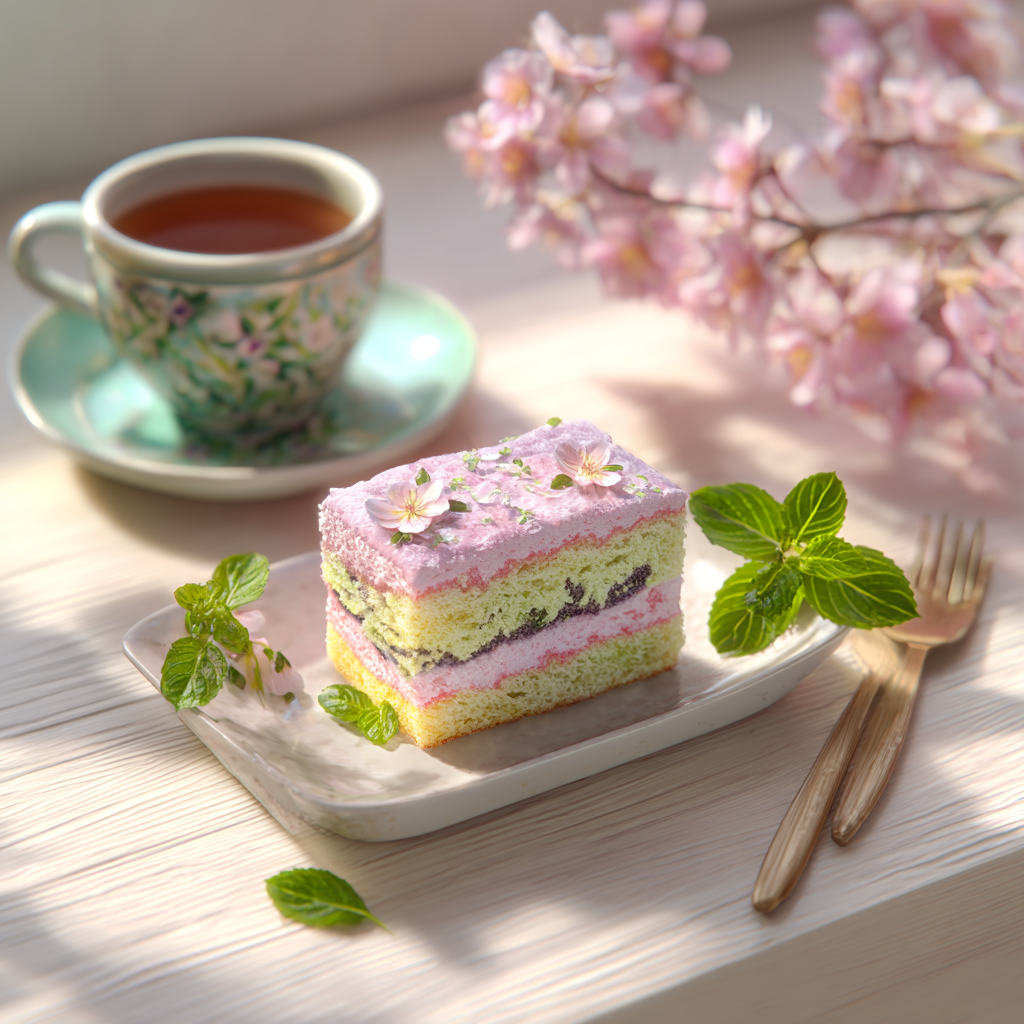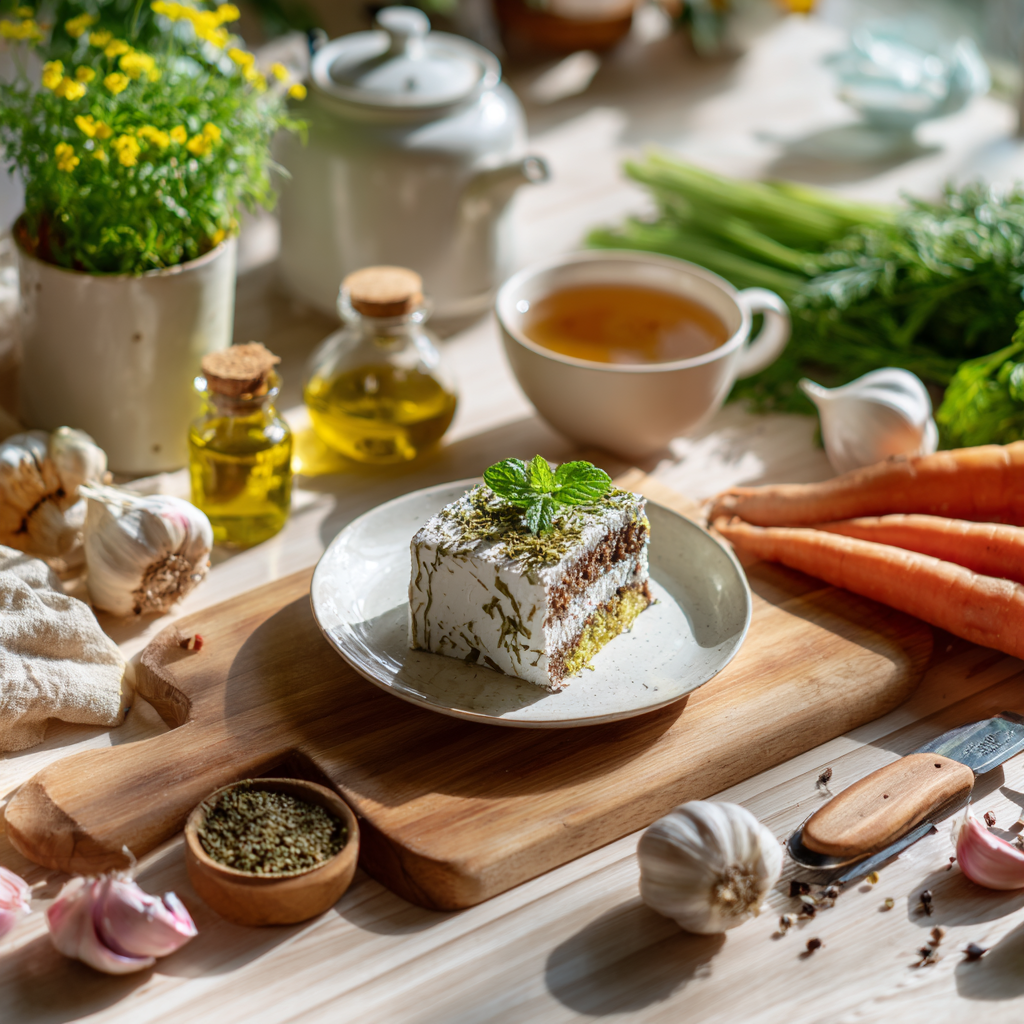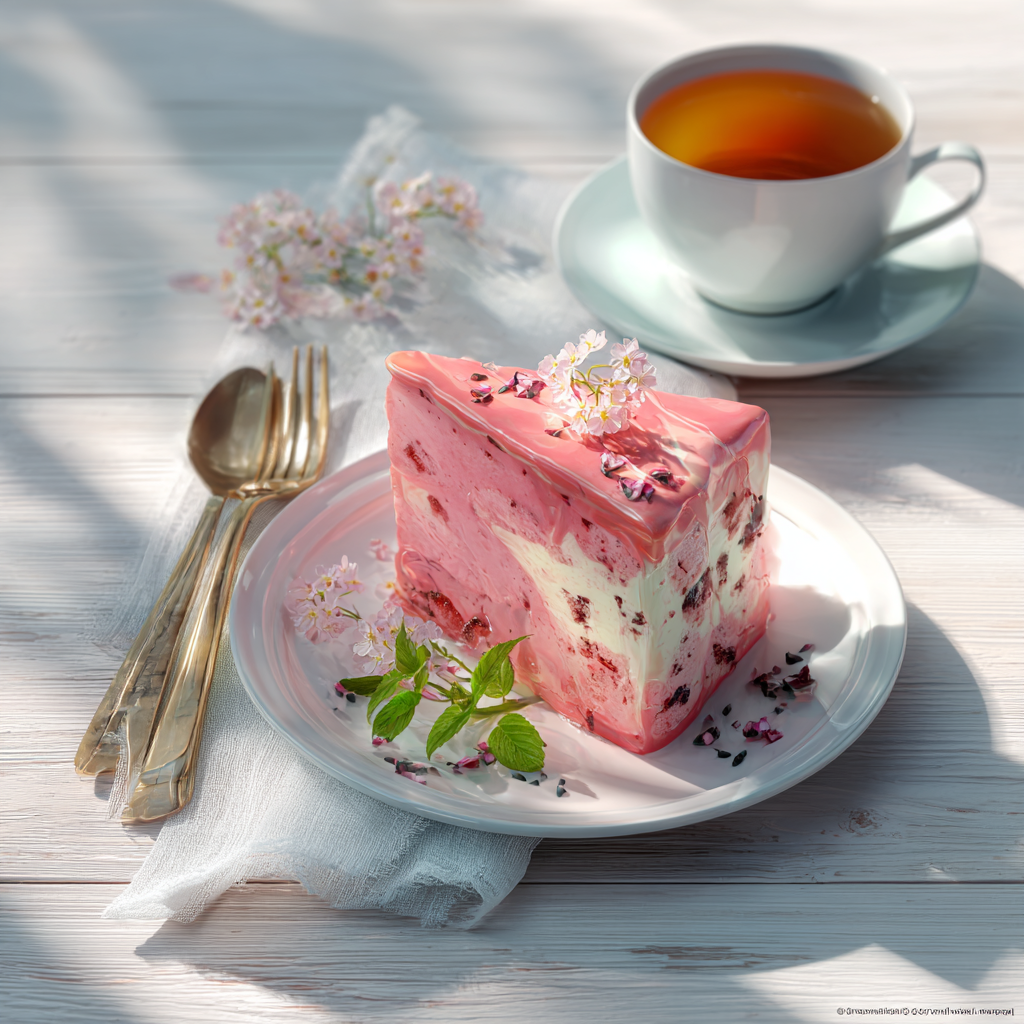
Introduction
I still remember the first time I tried sakura cake. It was a small, delicate slice served at a Japanese tea house during spring. The soft pink hues of the cake matched the cherry blossoms blooming outside. One bite, and I was hooked. The floral aroma, the subtle sweetness—it felt like tasting spring itself. That moment sparked my love for unique desserts, especially those tied to culture and tradition.
Sakura cake isn’t just a dessert; it’s a celebration of Japanese culture and the fleeting beauty of cherry blossoms. For me, it’s a reminder of how food can connect us to nature and history. In this article, you’ll learn about its flavors, ingredients, and cultural meaning. I’ll also answer common questions like What is the flavor of sakura? and What is sakura made of? By the end, you’ll understand why this cake is so special.
What is Sakura Cake?
The Flavor of Sakura
If you’ve ever wondered What is the flavor of sakura?, you’re not alone. Sakura has a taste that’s hard to describe but easy to love. Imagine a mix of floral notes, gentle sweetness, and a hint of tanginess. It’s light, refreshing, and unlike anything else. When I tasted sakura cake for the first time, I was surprised by how balanced it was. The sweetness wasn’t overpowering, and the floral notes added a layer of complexity that felt almost poetic.
Many people ask if sakura tastes like cherries. The truth is, sakura and cherries are not the same. Cherries are fruity and bold, while sakura is delicate and fragrant. Think of sakura as capturing the essence of spring in a single bite. This unique flavor comes from sakura extract or salted sakura blossoms, which are often used in traditional Japanese desserts.
Ingredients That Define Sakura Cake
So, What is sakura made of? The magic lies in a few key ingredients. Here’s a breakdown:
- Sakura Extract: This liquid captures the floral essence of cherry blossoms. A little goes a long way in adding flavor to cakes and other treats.
- Salted Sakura Blossoms: These preserved flowers are both decorative and flavorful. They add a salty-sweet contrast that makes sakura cake stand out.
- Rice Flour: Often used in Japanese baking, rice flour gives the cake a soft, tender texture.
- White Bean Paste: Some recipes use this sweet paste for filling. It’s creamy, subtly sweet, and pairs beautifully with sakura flavors.
These ingredients aren’t just tasty—they’re meaningful too. Salted sakura blossoms, for example, are a symbol of renewal and the transient nature of life. They remind us to appreciate the present moment, much like the short-lived bloom of cherry blossoms each spring.
Finding these ingredients might seem tricky, but they’re worth the effort. Many Asian grocery stores carry sakura extract and salted blossoms. You can also find them online. If you’re new to Japanese baking, start with small amounts. These ingredients pack a lot of flavor, and a little really does go a long way.
Why Sakura Cake Stands Out
Some cakes are flashy or over-the-top, but sakura cake is different. Its beauty lies in simplicity. The soft pink color, the delicate flavor—it’s all about subtlety. Yet, it’s not just any dessert. Sakura cake carries deep cultural significance. In Japan, cherry blossoms represent the fleeting nature of life. Eating sakura cake feels like honoring that idea, savoring something beautiful while it lasts.
For those who love luxury desserts, sakura cake might not be the most expensive cake. (That title goes to creations studded with gold or rare ingredients.) But its value isn’t in price—it’s in meaning. Every bite tells a story of spring, tradition, and connection to nature. To me, that makes it priceless.
Next, we’ll dive deeper into the cultural importance of sakura cake and explore how it fits into Japanese celebrations. Whether you’re a seasoned baker or just curious about unique desserts, you’ll find plenty to love about this enchanting treat.
Why Sakura Cake Stands Out
By the way, there’s something about sakura cake that makes it feel worlds apart from other desserts. Sure, we’ve already touched on its delicate flavor and cultural significance, but let’s dig a little deeper into what truly sets it apart. For starters, people often get confused between sakura and cherries. I know I did when I first encountered it!
Is Sakura the Same as Cherry?
Here’s the thing—sakura isn’t the same as the cherries you’re probably thinking of. When someone mentions “cherry,” most of us picture those juicy, red fruits that are perfect for pies or snacking. But sakura refers to cherry blossoms, not the fruit. The difference is huge. Western cherries are bold, sweet, and sometimes tart, while sakura brings a more subtle, floral vibe to the table.
I remember going to a farmer’s market once, excited to find fresh cherries. A vendor handed me a sample, and I bit into it expecting that familiar burst of sweetness. Instead, it was… different. Turns out, I had accidentally grabbed a jar of preserved sakura blossoms nearby. It wasn’t bad—it was just unexpected! That moment taught me how distinct these two really are. So, if you’re wondering Is sakura the same as cherry?, the short answer is no. They might share a name, but their flavors and uses are entirely unique.
The Artistry Behind Sakura Cake
Let’s talk about presentation for a second. Sakura cakes aren’t just delicious—they’re works of art. Have you ever seen one up close? The first time I did, I couldn’t stop staring. It was this gorgeous confection with layers of pale pink sponge, adorned with actual edible sakura flowers. It felt almost too pretty to eat. Almost.
In Japanese culture, aesthetics matter—a lot. Every detail, from the soft pastel colors to the placement of each blossom, reflects a deep appreciation for balance and harmony. This ties back to traditional Japanese design principles, where simplicity and elegance reign supreme. Funny enough, it reminded me of making a Harry Potter cake once, where every element had to be precise to capture the magic of the theme. Except with sakura cake, the “magic” comes from nature itself.
What struck me most was how the decoration didn’t overpower the dessert. Instead, it complemented it. The edible flowers weren’t just slapped on haphazardly; they were carefully arranged to enhance the overall experience. It made me realize that baking isn’t just about taste—it’s about creating something that delights all your senses.
Comparing Sakura Cake to Other Luxurious Desserts
Now, let’s zoom out a bit. How does sakura cake stack up against some of the fanciest, most extravagant desserts out there? Because let’s face it, luxury in the world of cakes can mean very different things depending on where you look.
How Does It Compare to Expensive Cakes Globally?
If we’re talking sheer price tags, sakura cake doesn’t come close to the record holders. Take the most expensive cake ever made, for instance. Rumor has it, one cake sold for over $75 million thanks to being encrusted with diamonds and rare gems. Yeah, you read that right—diamonds. While that’s certainly jaw-dropping, I have to ask: would you even want to eat it? Personally, I’d rather stick to something like a mil hojas cake or, better yet, a slice of sakura cake.
Sure, sakura cake may not glitter with gold leaf or precious stones, but its value lies elsewhere. Think about the craftsmanship involved. From sourcing authentic sakura extract to perfecting the texture of the sponge, every step requires skill and care. Plus, there’s the rarity factor. Not everyone has access to high-quality sakura ingredients, which makes finding—or making—a genuine sakura cake feel like discovering a hidden gem.
Reflecting on this got me thinking about another show-stopping dessert I tried recently: a Barbie cake. Don’t get me wrong, it was stunning, with its bright colors and playful design. But it lacked the quiet sophistication of sakura cake. There’s something about the understated elegance of sakura that feels timeless, whereas themed cakes can sometimes feel trendy or fleeting.
A Different Kind of Luxury
Luxury doesn’t always mean flashy, though. Sometimes, it’s about intention and meaning. With sakura cake, every ingredient tells a story. The salted blossoms symbolize renewal, while the soft hues evoke the ephemeral beauty of spring. Eating it feels like participating in a centuries-old tradition, connecting you to something larger than yourself.
It’s funny because, growing up, my idea of a luxury dessert was anything chocolatey and rich, like a decadent molten lava cake. But now, I find myself drawn to desserts that offer more than just indulgence. Take the lemon pound cake strain, for example. Its zesty brightness and comforting texture remind me of simpler times, much like sakura cake does. Both are proof that sometimes, the best desserts are the ones that make you feel something.
Final Thoughts on Sakura Cake’s Place in the Dessert World
So, could sakura cake be considered luxurious? Absolutely. But not in the conventional sense. Its luxury stems from its ability to transport you—to a blooming garden in Kyoto, to memories of springtime picnics, or even to moments of quiet reflection. It’s not trying to impress you with glitz or glam. Instead, it invites you to slow down and savor the moment.
And honestly, isn’t that what luxury should be about? Whether you’re comparing it to diamond-studded creations or whimsical themed cakes, sakura cake holds its own. It’s a reminder that true richness comes from experiences, emotions, and connections—not just price tags. Next time you’re craving something special, skip the over-the-top options and give sakura cake a try. Trust me, your soul will thank you.
Making Your Own Sakura Cake at Home
Alright, let’s get into the fun part—making your own sakura cake. I’ll admit, when I first decided to bake one, I was intimidated. The idea of working with unfamiliar ingredients like sakura extract and salted blossoms felt a little out of my comfort zone. But guess what? It turned out to be one of the most rewarding baking experiments I’ve ever done. By the way, if you’re wondering whether it’s worth the effort, trust me—it absolutely is.
Tips for Baking Sakura Cake
Here’s the thing about baking sakura cake: it’s not rocket science, but there are a few key steps that can make or break your dessert. First off, you’ll need a good sponge base. My go-to method is using rice flour instead of all-purpose flour. Why? It gives the cake this light, almost melt-in-your-mouth texture that pairs perfectly with the delicate sakura flavors. If you don’t have rice flour on hand, no worries—you can still use regular flour, but the texture might be slightly denser.
Now, onto the flavoring. Sakura extract is your best friend here. A teaspoon or two is usually enough to infuse the batter with that signature floral aroma. Funny enough, the first time I used it, I accidentally added too much. Let’s just say my kitchen smelled like a cherry blossom forest for days. Lesson learned: less is more!
- Sourcing Ingredients: If you’re struggling to find sakura extract or salted blossoms locally, check online retailers or specialty Asian grocery stores. I’ve had great luck ordering from Japanese import shops—they often carry high-quality ingredients.
- Experimentation: Don’t be afraid to tweak recipes. For example, I once swapped white bean paste for almond cream filling because I wanted something nuttier. It worked beautifully and gave the cake a unique twist.
- Presentation Matters: Take your time decorating. Edible sakura flowers aren’t just tasty—they’re stunning. Arrange them thoughtfully to create a cake that looks as good as it tastes.
Baking sakura cake isn’t just about following instructions; it’s about embracing the process. There’s something magical about mixing these ingredients together and watching them transform into a dessert that feels so deeply connected to nature and tradition.
My Favorite Sakura-Inspired Variations
Once you’ve mastered the basics, why not get creative? One of my favorite twists is adding a layer of matcha cream between the cake layers. The earthy bitterness of matcha balances the sweetness and floral notes of sakura beautifully. It’s like a flavor hug for your taste buds.
Another idea? Try making mini sakura cupcakes instead of a full-sized cake. They’re perfect for parties or gifting. I once made a batch for a friend’s birthday, and everyone raved about how cute and delicious they were. Plus, they’re easier to portion control (not that I needed help eating three in one sitting).
If you’re feeling adventurous, consider incorporating other seasonal elements. For instance, during peach season, I added diced peaches to the batter. The juicy bursts of fruit complemented the sakura flavor in ways I didn’t expect. Honestly, the possibilities are endless, and that’s what makes baking sakura cake so exciting.
Encourage yourself to personalize your creations. Maybe you love citrus flavors—why not add a splash of yuzu juice? Or perhaps you’re a fan of mochi textures; try folding some cooked mochi bits into the batter. The point is, sakura cake is a canvas waiting for your unique touch.
Frequently Asked Questions About Sakura Cake
Before we wrap things up, let’s revisit some common questions people ask about sakura cake. Think of this as your quick-reference guide.
- What is the flavor of sakura?
Sakura has a light, floral taste with a hint of sweetness and tanginess. It’s subtle yet complex, evoking the essence of springtime. - What is sakura made of?
Traditional sakura cakes use ingredients like sakura extract, salted sakura blossoms, rice flour, and sometimes white bean paste. Each component adds depth and meaning to the dessert. - What is the most expensive cake?
The title goes to a diamond-encrusted cake valued at over $75 million. While impressive, its appeal lies in extravagance rather than flavor or cultural significance. - Is sakura the same as cherry?
Nope! Sakura refers to cherry blossoms, while cherries are the fruit. Their flavors and uses differ significantly, with sakura offering a more floral profile. - Can I substitute sakura extract?
If you can’t find sakura extract, try using rosewater sparingly as an alternative. Keep in mind the flavor won’t be identical, but it’ll still evoke a floral vibe. - Where can I buy sakura ingredients?
Look for them at Asian grocery stores or online retailers specializing in Japanese imports. Quality matters, so choose reputable sources. - How do I store sakura cake?
Store it in an airtight container in the fridge for up to three days. Bring it to room temperature before serving for optimal flavor. - Are sakura blossoms edible?
Yes, but only if they’re specifically labeled as edible and properly prepared. Salted sakura blossoms are safe and commonly used in desserts. - Can I freeze sakura cake?
Technically, yes, but freezing may affect the texture. If you decide to freeze, wrap it tightly to prevent freezer burn. - Why is sakura cake so special?
Beyond its unique flavor, sakura cake celebrates Japanese culture and the fleeting beauty of cherry blossoms. It’s a dessert that connects us to nature and tradition.
If you’re eager to explore more cake ideas, head over to our cakes and cupcakes category. You’ll find tons of inspiration to fuel your next baking adventure.
Conclusion
Sakura cake isn’t just a dessert—it’s a celebration of life, culture, and the ephemeral beauty of spring. Whether you’re baking it for yourself or sharing it with loved ones, every bite carries a sense of mindfulness and appreciation. So, grab those ingredients, roll up your sleeves, and give it a shot. Who knows? You might discover a new favorite dessert along the way.
And hey, don’t stress if it doesn’t turn out perfect the first time. Baking is as much about the journey as it is about the destination. Cheers to exploring new flavors and creating memories in the kitchen—one slice at a time.

Equipment
- Mixing bowls
- Whisk
- Spatula
- Baking pan
- Oven
Ingredients
- 200 ml Sakura extract
- 50 g Salted sakura blossoms
- 200 g Rice flour
- 100 g White bean paste optional
Instructions
- Preheat your oven and prepare the baking pan.
- In a mixing bowl, combine rice flour and other dry ingredients.
- In another bowl, whisk together wet ingredients including sakura extract.
- Gently fold the wet ingredients into the dry ingredients until just combined.
- Pour the batter into the prepared baking pan and smooth the top.
- Bake in the oven until a toothpick inserted comes out clean.
- Allow the cake to cool before removing from the pan.
- If using, spread white bean paste between layers when assembling.
- Decorate the top with salted sakura blossoms and other edible decorations.
- Serve and enjoy your sakura cake!


